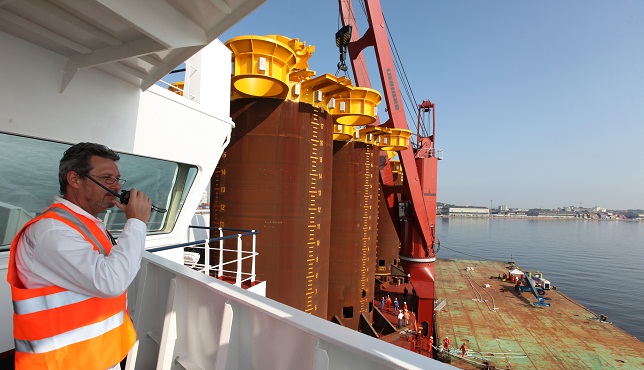Executive in Action: Captain Yuriy Malanin, Master of EIT Paloma
It?s all about teamwork.
Captain Yuriy Malanin is playing a part in Brazil’s development of its offshore oil and gas fields. Master of the heavy lift vessel EIT Paloma, he recently delivered eight suction piles, 24m high and weighing 220 tons each, and 32 counterweights weighing 145 tons each for use in the set-up of a new FPSO for Petrobras. It was a delivery project six months in development for Combi Lift, a joint venture between Harren & Partner of Germany and J. Poulsen Shipping of Denmark, and it culminated in an 11,275 mile journey from Quindao in China to Rio de Janeiro in Brazil.
142m long, EIT Paloma was built in 2010 by Rolandwerft of Germany and is equipped for carriage of containers, cars and heavy cargo. The vessel has two heavy lift cranes with a safe working load of 350mt each that can lift 700mt in tandem. The ship’s design, with a roro box-type cargo hold and open decks, meant the cranes could load quickly and economically, just 75 minutes for each suction pile and 25 minutes for each counterweight.
During cargo loading and once at sea, it is all about teamwork, says Malanin, although as master he also feels a sense of isolation. “I am the first seaman in my family. It was my only ambition, and I was very clear about wanting to be captain. It is probably the desire for leadership. But with that, a captain’s life, experience and feelings are completely different from others such as marine engineers or bosun, for example. I had heard about this in the past. Now I know it’s true.”
Malanin admits to being a romantic. “I am a traveller and a discoverer, but I also like modern conveniences. Therefore to discover the world on a modern vessel like EIT Paloma is a double pleasure. The crew tend to have different feelings about being a sailor. Usually they are financial. But I love the sea.”
The 820-hour voyage to Rio took Malanin through the Taiwan Strait and South China Sea, on to Singapore, past Madagascar, around the Cape of Good Hope, and then to Rio. The journey also took him through three tropical storms and Cyclone Felleng, which meant the vessel was subject to 6-8m waves and winds that reached 90 knots.
Normally he is on the bridge for eight to 10 hours a day but during storms it can be a 24-hour job. “I am always very serious when we have a storm. We cannot explain to the ocean that today we are not ready for a storm,” says Malanin. Still, dealing with it is a routine part of the job, and Meteo Consult’s SPOS weather service is used on board to avoid heavy weather as much as possible. “We follow company instructions and manuals – which we have a lot of.”
Old vs. New
Malanin has been a master for 20 years now on general cargo, heavy lift, reefers and container vessels before joining Harren & Partner and Combi Lift in 2001. Life on board can become routine, each day the same story and always it is about the sea. The old rituals that used to be used to break the monotony are fading. “We tried to continue the seamen’s traditions, but this is not as common now as 20 years ago. The new generation choose computers instead.”
So now, the ritual of asking King Neptune for permission to enter his waters with a ‘newbie’ or ‘greenhorn’ on board is only performed about a third of the time the vessel crosses the equator. These rituals pose a challenge or punishment for the newbie that can involve grease or seawater, after which they receive a certificate and the crew enjoys a barbeque.
“The cooks are very important, I even say that the cook has more authority than captain,” jokes Malanin. “Of course we have some food traditions, but they are seldom followed nowadays - like salted herring and boiled potatoes for Monday breakfast, a tradition of Russia’s fleet since Tsar Peter the First in the 1600s. But for birthday celebrations we always have a cake, and Sunday dinner has to be special. It’s the single joy in life during a long sea passage – well, that’s a joke but with some truth in it.”
Through all the ritual and the routine, the job the seafarers are being paid for gets done. At Rio, the suction piles are offloaded in just 55 minutes each and the counterweights in just 20 minutes each. So the cargo that took five days to load was discharged in just three-and-a-half. It will be used in the construction of subsea structures for the 2,200m deep Guará and Lula NE projects off Brazil.
EIT Paloma has set sail again, and Malanin is ready for new horizons, looking to add to the 100 countries he has already visited. He has sailed on this ‘beautiful lady’ for three years now, but the company has plans for some newbuildings and his seniority means he could move on. “We’ll see,” he says. – MarEx
The opinions expressed herein are the author's and not necessarily those of The Maritime Executive.

